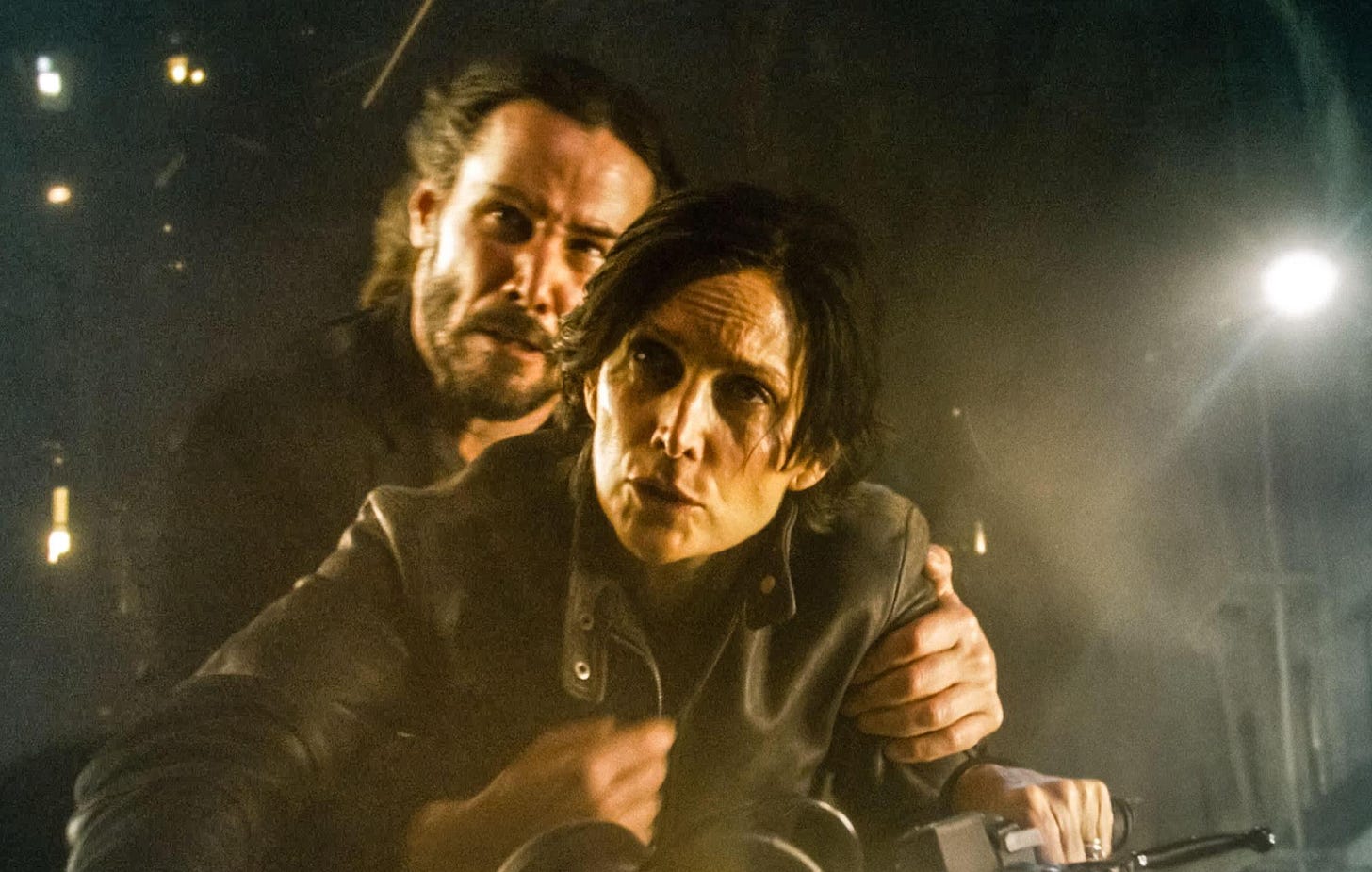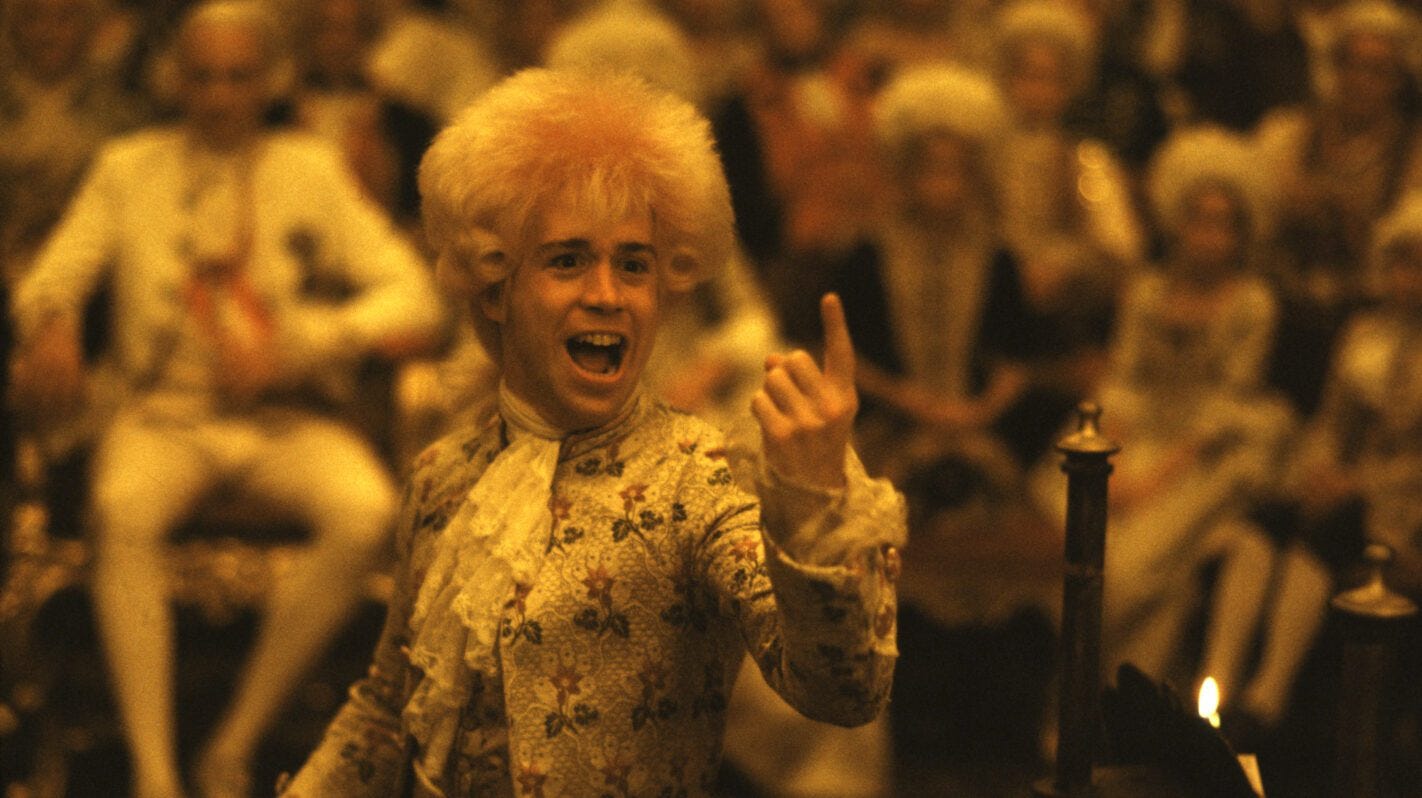I want to keep my reviews and essays free—like the hot dog chili at 711—but I need your support to continue doing so. $5/$50/$75. Help keep me off the streets and hunched over a computer, writing reviews of sexy Nicole Kidman movies.
Director Lana Wachowski’s 2021 cerebral sci-fi actioner The Matrix Resurrections wasn’t just the third sequel to The Matrix, the sci-fi blockbuster she and her sibling Lilly wrote and directed in 1999.
It was also a dream come true for IP-hungry executives who had patiently prayed 18 years for another lucrative entry in The Matrix franchise and a generation’s worth of superfans who still can’t get enough stylish slow-motion cyberpunk kung-fu.
But to lone Lana, The Matrix Resurrections was a coda. It’s not another chapter but a farewell. You can tell she was bored with the spectacle of the original movies. The sunglasses budget is massive in this final sequel, but the action is uninspired. Muted. Like her other movies, Wachowski investigates what is and isn’t real but comes up with a final answer. An answer that doesn’t require sword fights and car chases that defy the laws of physics.
This possible final Matrix installment would have been a cynical cash grab without Wachowski’s secret mission. She had something she wanted to say about the insanely successful franchise she co-created with her sister. I am sure she never told the suits she was making a Matrix movie that clearly says, “The Matrix is cool, but have you ever truly been in love with someone?” But that’s precisely what she did, and because of that, The Matrix Resurrections is only a partially cynical cash grab. One can have one’s cake and eat it too, even if The Merovingian baked it.
The Matrix Resurrections echos its older siblings — some scenes are respectfully similar to The Matrix, The Matrix Reloaded, and The Matrix Revolutions, but those moments feel perfunctory. That’s what a sequel is supposed to do, right? Serve up the same ol’ slop? And while The Matrix Resurrections doesn’t have sublime moments of mayhem like Reloaded or impenetrable pseudo-philosophical argle-bargle like Revolutions, it does have something special — a clear message.
The Matrix Resurrections isn’t just a would-be blockbuster, it’s more like a cinematic essay about The Matrix. It’s a thoughtful, deeply emotional reaction to a pop art phenomenon that ate and digested reality. Wachowski has strong feelings about her cultural Frankenstein’s monster; if you’re a fan of her movies, you’ll likely have strong feelings, too. (I will always love Jupiter Ascending.)
I think The Matrix Resurrections is wonderful. Zippy, weird, heartfelt. Eminently rewatchable. It’s streaming on Max.
In The Matrix Resurrections, we are reunited with Keanu Reeves’ character, Thomas Anderson. He’s the office nobody from The Matrix who was presented with a trippy choice between two magic pills, one blue and one red, by Lawrence Fishburne’s Morpheus, a cool-as-hell Obi-Wan who looked like a cross between a Blade Runner and a divorced dad’s black leather couch.
Fishburne isn’t in The Matrix Resurrections and is missed. Instead, Morpheus is reincarnated and played by Yahya Abdul-Mateen II, who, to be fair, is a lightning bolt of charm.
The blue pill, famously, returns Mr. Anderson to his safe but dull world. The red pill, however, introduces him to the truth, and that revelation ends up being one of the most famous plot twists in modern movie history (right after “I see dead people”).
Reeves’ character wakes up in a pod filled with pink salvia; he’s bald and hooked up to strange alien machines and is then rescued by humans who have been fighting alien machines for centuries. Mr. Anderson—soon to be Neo—then learns that his life was false and that humans are living batteries who live in a metaverse and are entirely, blissfully ignorant about their true purpose.
The choice between knowing nothing and knowing everything is at the heart of the first Matrix movie. It is the heart of The Matrix Resurrections. However, Wachowski wants to clarify a few things, especially since The Matrix’s influence has gotten slightly ridiculous and out of hand.
The red pill plot point has become one of the most popular concepts of this still young century, for better or worse, and I’d argue mainly for the worst.
The Matrix is beloved and worshipped by a demo that is traditionally prized by reactionary political forces, and that is young men. If you want to appeal to and persuade a group of people, you have to speak their language. So, for the past decade, especially, America’s conservatives have coopted the blue pill/red pill binary and used it as a recruitment strategy to win the hearts and minds of impressionable dudes.
Once you command the attention and respect of a young man, you can easily convince them that cruelty first and then violence, solves most of life’s problems.
The conservative red pill pitch is simple: the blue pill is for liberals, feminists, trans people, people of color, vegans, hippies, and anyone who supports universal healthcare or who thinks climate change is real, and the red pill reveals the truth, which is that white men are the real victims in America. They are oppressed. The people in charge are not, in fact, mostly old white men, so don’t believe your eyes. These young men never question why the red pill reaffirms their pre-existing prejudices. And why should they? That’s no fun.
The red pill dynamic is hopelessly cliche by now anyway; it’s a marketing jingle. Burger King may as well offer their customers a red pill while asking the question, “What if I told you Big Macs don’t exist?”
But the damage has been done. The internet, with its many social media fiefdoms, is chock full of blue pills painted red by aspiring cult leaders looking to flatter insecure men into buying their anarchist e-books or male enhancement supplements. Meanwhile, The Matrix has become a quickly fading pop culture reference, a dimly remembered, vaguely fascist, ultraviolent, green-tinted cartoon in tight pants full of ancient hokey catchphrases.
The Matrix Resurrections is full of self-referential jokes, callbacks, and new ideas, like a future where humans and some of the thinking machines are allied, but this is a movie about two people who can change the universe with a kiss. So it’s also different. And I think that makes the film special. Feisty.
There is also a sly lack of respect for The Matrix, which is refreshing. The Matrix Resurrections recasts a few famous roles and introduces a new villain, but none of that matters. Not really. Wachowski allows herself to have some fun before hammering home the point, or should I capitalize that? The Point.
As the new baddie, Neil Patrick Harris is a smirking menace, a malevolent machine that takes the form of a sinister therapist. He prescribes Reeves’ character plenty of blue pills to keep him grounded in the Matrix.
I don’t think the fact that Harris’ character is a shrink is Wachowski making a statement about mental health. But make sure your therapist is not an evil enemy of love if you can help it.
In The Matrix Resurrections, Reeves’ Anderson is a video game designer whose biggest hit is The Matrix, inspired by his dreams, which are distant, suppressed memories. There’s an especially arch scene where Anderson and a team of corporate cogs brainstorm a sequel to Anderson’s creation. This group brainstorm includes moments where the underlings wonder aloud what The Matrix series was about: capitalism? Politics? Philosophy? It’s very self-aware and very funny. Even “bullet time,” the groundbreaking CGI special effect in The Matrix, is a punchline.
This tongue-in-cheek scene might suggest The Matrix Resurrections is, at least partly, a satire, but it isn’t. The levity isn’t commentary; it’s playfulness—a prank. Wachowski is gently, lovingly making fun of The Matrix’s legacy, fans, and even its instantly recognizable shiny black aesthetic.
Her greatest gag, however, is a coffee date between Neo, Reeves’ character’s true self, and Trinity, played by the magnificent Carrie-Ann Moss. These two have been re-trapped in the Matrix and have forgotten their past lives. They have forgotten each other.
The best scene in the movie is between two middle-aged heroes whose love is so powerful an army of sentient robotic squids can’t keep them apart. Anderson and Moss’s character, who goes by the name Tiffany inside the Matrix, are drawn to each other. They share a cup of coffee. Their eyes meet. It is vulnerable; it is volcanic.
Later, Wachowski flips the script and allows a MILF to enjoy godhood for a change. It is always good to see Reeves do his SoCal Zen Master thing, but it’s tremendous to see Moss do it. She’s tender and fierce and regal. Ugh. I love her.
The Matrix Resurrections is a love story. It is about Neo and Trinity. That is all it’s about. The red pill is love—the end.
The reality we live in is a profoundly political experience, the result of eons of human struggle and greed and hope, a relay race between generations, some doing the best they can and others not so much, and accepting that this existence of ours, where the haves and the have nots, the rich and poor, powerful and weak, young and old, are in constant conflict for gold or guns or dominance, is a failure of imagination.
We can do better.
Love, mercy, compassion, connection. Two hearts, three, a family, a community, all striving together, feeding each other, holding each other in sorrow, and laughing with joy, this is the only order, the only society, that makes sense, and it’s our choice whether we can live there, in that dream, or not. We can thrive, not just survive—all of us, not a lucky cruel few.
The Matrix is whatever we want it to be, and it should be a place of kindness, forgiveness, and love; we should work together, elevate our neighbor, walk into the darkness hand in hand, bind wounds and tell stories, and fall asleep in each other’s arms. We should spend our lives looking for the one, the ones, never giving up, and if you find him or her or them, then never let go.
The only other option is pure selfishness, raw hunger, claws and teeth and beady eyes. If you want to save the world, you must open your heart. Otherwise, you choose politics, and politics is suffering. Just animals eating animals, meat being stripped from skulls underneath the dead night sky.
The only thing that matters is love. Take the red pill. Go on. Take it. Here’s the truth: the only good in this life is because of love. Love is real. Everything else — fear, greed, anger— is the blue pill.










This is lovely. Thank you! Also, I am not a musician, but if I were I would consider "pseudo-philosophical-argle-bargle" to be an excellent album name.
I quite enjoyed the movie and have watched it more than once, for the reasons you list, and feel it's an excellent chapter in the book of its existence.